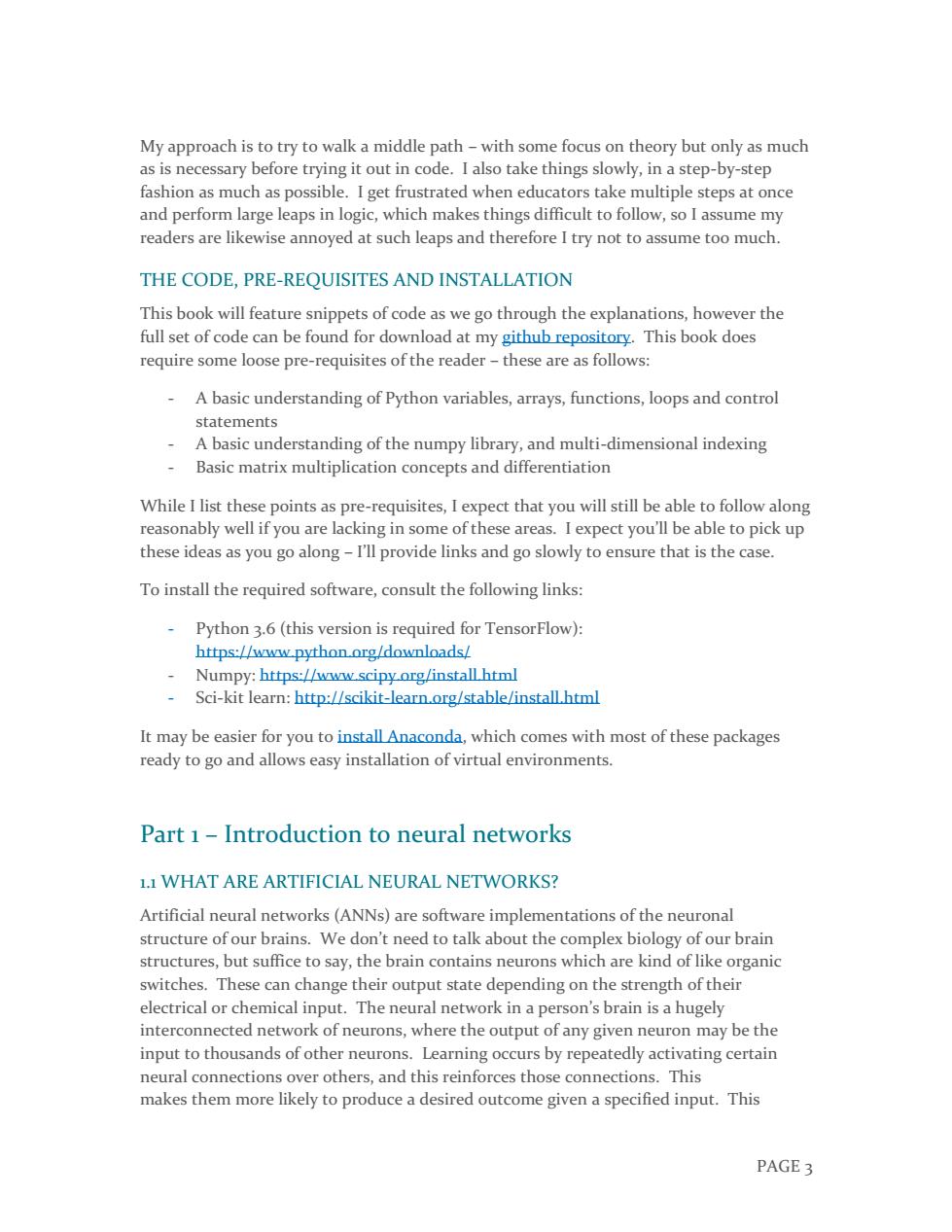正在加载图片...

My approach is to try to walk a middle path-with some focus on theory but only as much as is necessary before trying it out in code.I also take things slowly,in a step-by-step fashion as much as possible.I get frustrated when educators take multiple steps at once and perform large leaps in logic,which makes things difficult to follow,so I assume my readers are likewise annoyed at such leaps and therefore I try not to assume too much. THE CODE,PRE-REQUISITES AND INSTALLATION This book will feature snippets of code as we go through the explanations,however the full set of code can be found for download at my github repository.This book does require some loose pre-requisites of the reader-these are as follows: A basic understanding of Python variables,arrays,functions,loops and control statements A basic understanding of the numpy library,and multi-dimensional indexing Basic matrix multiplication concepts and differentiation While I list these points as pre-requisites,I expect that you will still be able to follow along reasonably well if you are lacking in some of these areas.I expect you'll be able to pick up these ideas as you go along-I'll provide links and go slowly to ensure that is the case. To install the required software,consult the following links: Python 3.6(this version is required for TensorFlow): https://www.python.org/downloads/ Numpy:https://www.scipy org/install html Sci-kit learn:http://scikit-learn org/stable/install.html It may be easier for you to install Anaconda,which comes with most of these packages ready to go and allows easy installation of virtual environments. Part 1-Introduction to neural networks 1.1 WHAT ARE ARTIFICIAL NEURAL NETWORKS? Artificial neural networks(ANNs)are software implementations of the neuronal structure of our brains.We don't need to talk about the complex biology of our brain structures,but suffice to say,the brain contains neurons which are kind of like organic switches.These can change their output state depending on the strength of their electrical or chemical input.The neural network in a person's brain is a hugely interconnected network of neurons,where the output of any given neuron may be the input to thousands of other neurons.Learning occurs by repeatedly activating certain neural connections over others,and this reinforces those connections.This makes them more likely to produce a desired outcome given a specified input.This PAGE 3PAGE 3 My approach is to try to walk a middle path – with some focus on theory but only as much as is necessary before trying it out in code. I also take things slowly, in a step-by-step fashion as much as possible. I get frustrated when educators take multiple steps at once and perform large leaps in logic, which makes things difficult to follow, so I assume my readers are likewise annoyed at such leaps and therefore I try not to assume too much. THE CODE, PRE-REQUISITES AND INSTALLATION This book will feature snippets of code as we go through the explanations, however the full set of code can be found for download at my github repository. This book does require some loose pre-requisites of the reader – these are as follows: - A basic understanding of Python variables, arrays, functions, loops and control statements - A basic understanding of the numpy library, and multi-dimensional indexing - Basic matrix multiplication concepts and differentiation While I list these points as pre-requisites, I expect that you will still be able to follow along reasonably well if you are lacking in some of these areas. I expect you’ll be able to pick up these ideas as you go along – I’ll provide links and go slowly to ensure that is the case. To install the required software, consult the following links: - Python 3.6 (this version is required for TensorFlow): https://www.python.org/downloads/ - Numpy: https://www.scipy.org/install.html - Sci-kit learn: http://scikit-learn.org/stable/install.html It may be easier for you to install Anaconda, which comes with most of these packages ready to go and allows easy installation of virtual environments. Part 1 – Introduction to neural networks 1.1 WHAT ARE ARTIFICIAL NEURAL NETWORKS? Artificial neural networks (ANNs) are software implementations of the neuronal structure of our brains. We don’t need to talk about the complex biology of our brain structures, but suffice to say, the brain contains neurons which are kind of like organic switches. These can change their output state depending on the strength of their electrical or chemical input. The neural network in a person’s brain is a hugely interconnected network of neurons, where the output of any given neuron may be the input to thousands of other neurons. Learning occurs by repeatedly activating certain neural connections over others, and this reinforces those connections. This makes them more likely to produce a desired outcome given a specified input. This